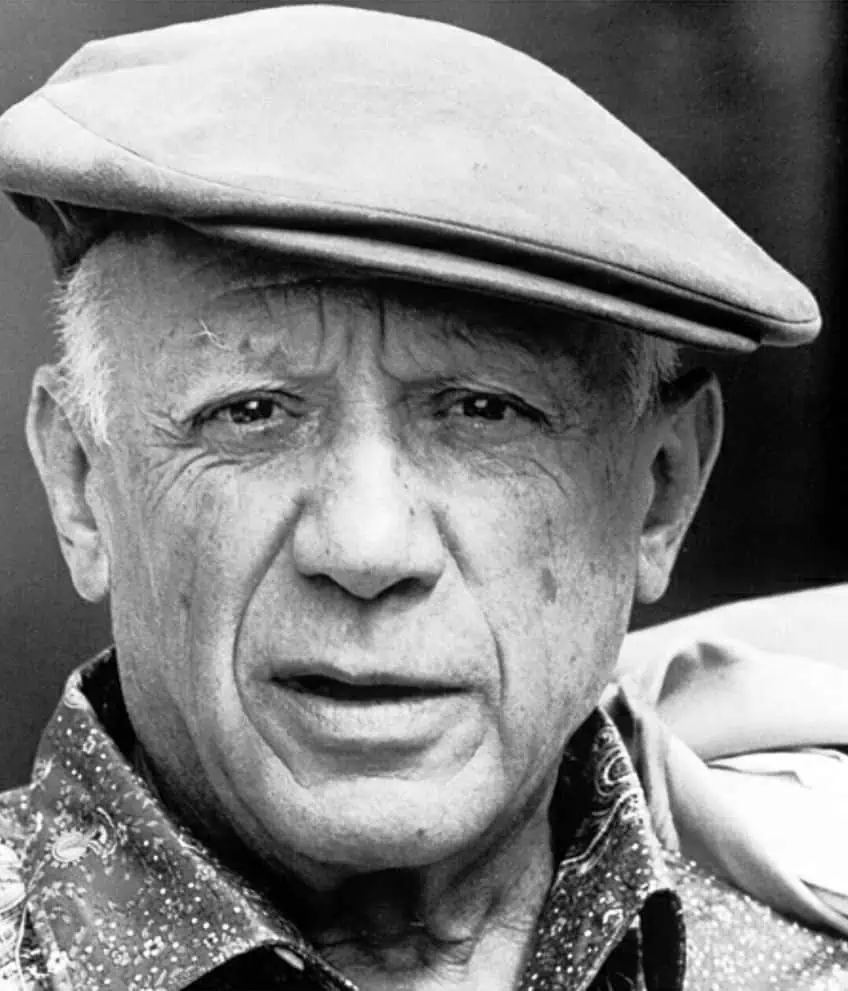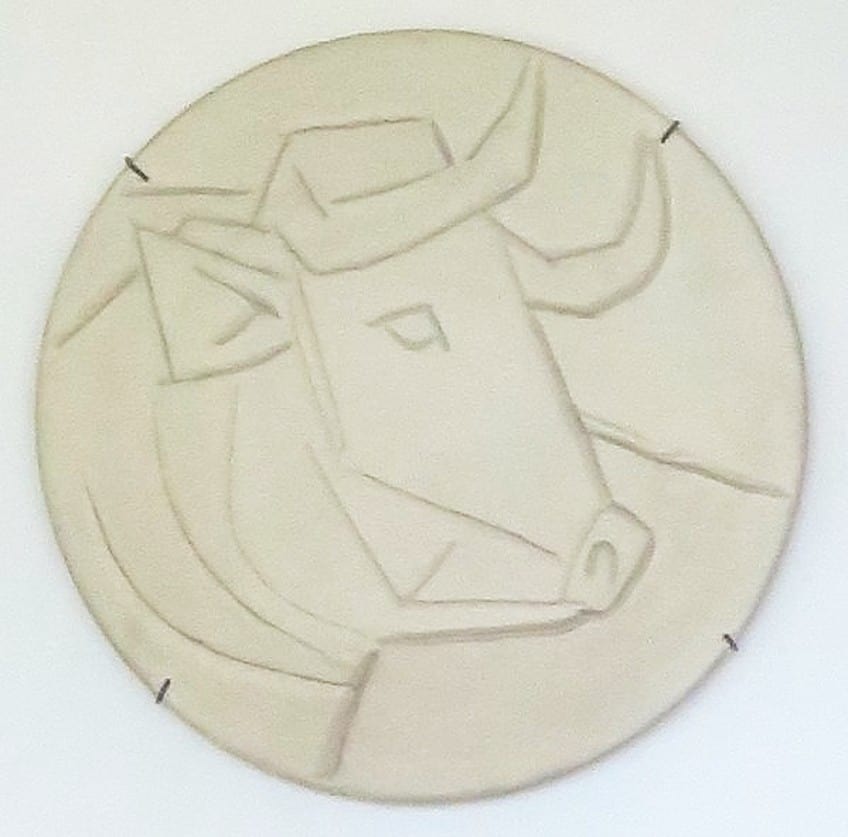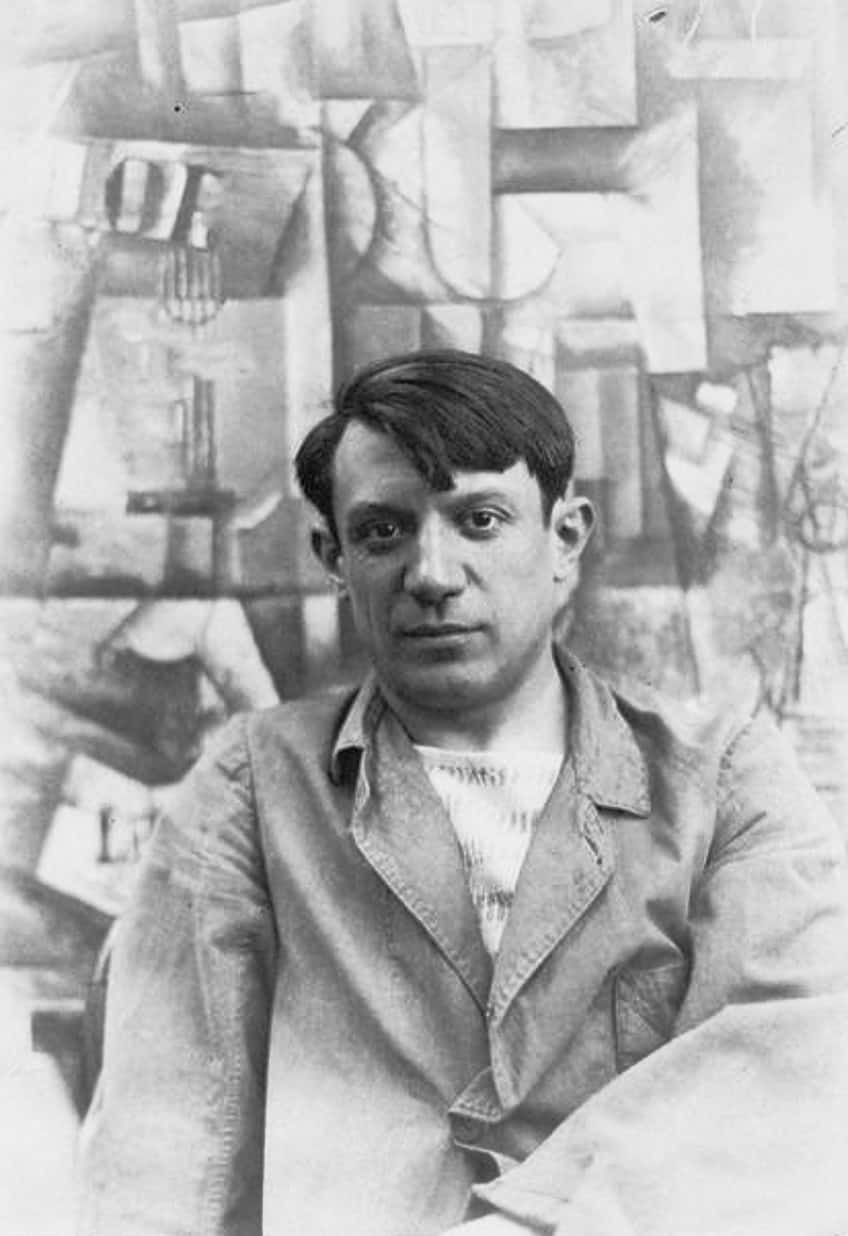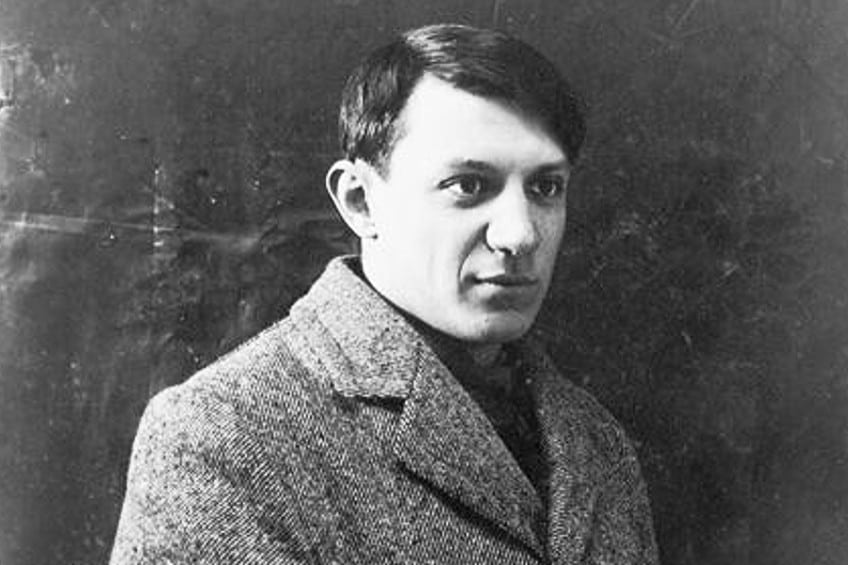“The Bull” by Picasso – Picasso’s Drawing from His Bull Series
Pablo Picasso’s distinctive style and innovative techniques have made him a household name and a cornerstone of modern art. Throughout his career, Picasso consistently explored a wide range of subjects and themes in his art, including the human form, still life, and landscape. One of the recurring motifs in his work is the bull, which has become a symbol of Picasso’s oeuvre and a fascinating subject for art historians and critics. In this article, we will look at a well-known lithograph series, titled The Bull. This article includes a The Bull analysis as well as a brief discussion of an example of a bull painting by Picasso.
Contents
Artist Abstract: Who Was Pablo Picasso?
Born in Malaga, Spain in 1881, Picasso showed a natural talent for art from a young age and began studying at the School of Fine Arts in Barcelona at the age of 14. Throughout his long and productive career, he dabbled in a variety of styles and movements, including Symbolism, Surrealism, and Cubism.
In 1900, Picasso moved to Paris, where he was introduced to a wide range of creative influences. He was particularly drawn to the work of Paul Cézanne and began to experiment with new approaches to form and composition.
This experimentation led to the development of his Blue Period, which lasted from 1901 to 1904 and was characterized by a focus on themes of loss, sadness, and isolation. In 1907, Picasso and his fellow artist Georges Braque began to experiment with the concept of Cubism, a revolutionary art movement that emphasized the fragmentation and reassembly of objects into abstract, geometric forms. Picasso’s 1907 masterpiece Les Demoiselles d’Avignon (1907) is considered to be one of the earliest examples of Cubist art.

Throughout his career, Picasso remained constantly productive, creating thousands of paintings, sculptures, and other works of art. In addition to his contributions to the art world, he was also a political activist who used his art to comment on the social and political issues of his time. He was a vocal opponent of fascism and was in favor of the Republican force during the Spanish Civil War. Picasso continued to work and create until his death in 1973 at the age of 91.
Throughout his life, he remained at the forefront of the art world, and his innovations and experiments continue to inspire and influence artists to this day. His rich legacy and enduring impact on the world of art make him one of the most significant figures in modern art history.
The Bull by Picasso in Context
| Date | 1945 – 1946 |
| Medium | Lithography on paper |
| Style | Cubism |
| Series | Eleven developments of a lithograph |
| Genre | Animal |
| Theme | Bull |
| Dimensions (cm) | 29.2 x 39.5 |
| Location | Museum of Modern Art (MoMA), New York City, United States |
At the time that Picasso created The Bull series, he was already an established and highly respected artist. He had been working in the field of modern art for many years, and he had produced many of his most famous works, including Les Demoiselles d’Avignon (1907) and Guernica (1937).
In The Bull series, Picasso drew upon his love of bullfighting and his deep knowledge of the form to create a series of dynamic and powerful prints.
Overall, The Bull: Eleven Lithographs is an important example of Picasso’s skill as a printmaker and his enduring interest in bullfighting as a subject for his art. It is a significant work in the artist’s career and remains highly regarded by art critics and collectors alike.
A Brief Socio-Historical Overview of The Bull by Picasso
The Bull: Eleven Lithographs was created by Pablo Picasso in Paris from 1945 to 1946. At the time, the city was still recovering from the devastation of World War II, and much of the art world was focused on rebuilding and redefining itself in the aftermath of the conflict.
Despite the difficult circumstances, Paris remained a center of artistic innovation, and Picasso was one of the leading figures in the city’s art scene.

He had been living and working in Paris for many years, and he was known for his unique style and his willingness to experiment with different mediums and techniques. The Bull series was created during a time of great change and uncertainty, but it stands as a testament to Picasso’s enduring talent and creativity.
The Bull Analysis: Experiments in Lithographs
The Bull: Eleven Lithographs is a series of prints by Pablo Picasso, created in 1945. The series consists of eleven prints, each of which depicts a different stage in the life of a bull. This series has become a practical example of how to abstract any shape from realism to its basic form. In the following section, we will do a visual analysis of this series.

Compositional Overview of The Bull by Pablo Picasso
A different variation of a bull illustration is printed in the middle of each print. There is nothing around or behind each bull – only the ground is included as a simple line beneath each animal. With the bull in the center of each composition, there is not a lot of compositional tension and the viewer’s attention is 100 percent directed toward each bull.
Color and Light
The Bull series is very toned down for a Picasso series. The only colors in the series of lithographs are the white of the paper and the black of the ink. The mark-making of the normal realistic bull prints has lighter shades of gray also included. This tined-down color style makes the series look more like a study and therefore focuses more attention on the style of abstraction Picasso wanted to highlight in this bull series.
Line and Form
In terms of line, The Bull: Eleven Lithographs is characterized by its strong diagonal lines and curves. The bull’s body is elongated and distorted, and its powerful muscles are emphasized by the use of bold, curving lines. These lines create a sense of movement and dynamism and help to convey the animal’s strength and vitality.
In terms of form, the bull is rendered in bold, geometric shapes that give it a powerful and muscular appearance.
The animal’s body is elongated and distorted, and its muscles are exaggerated to create a sense of movement and tension. The use of geometric forms helps to create a sense of abstraction and simplification, which is characteristic of Picasso’s later work.
Symbolism: An Overview of The Bull by Picasso
Picasso first began incorporating the bull into his art in the early 1900s, during his so-called “Blue Period.” This was a time of great personal sorrow for the artist, who was struggling with poverty and the recent death of his friend Carlos Casagemas. Let us first look at the general symbolics of the bull figure before we do a bull analysis in Picasso’s work.
The Bull in Art History
The bull has a rich history and cultural significance, dating back to ancient civilizations where it was revered as a powerful and majestic animal. Greek mythology connects the symbol of the bull to the god Zeus. Zeus is known for changing into a bull to kidnap the beautiful Europa. In ancient Minoan culture, bulls were central to religious rituals and were often depicted in art and artifacts.
The bull also played a prominent role in Ancient Egyptian religion, where it was associated with the sun god Ra.
Youth and Death
An example of Picasso’s bull painting that he created early in his career is called The Old Bullfighter (1903), which depicts an elderly matador who has lost his vitality and vigor. The bull, which appears in the background of the painting, is emaciated and weak, symbolizing the decline of both the bullfighter and the sport of bullfighting itself. The painting is a poignant commentary on the ephemeral nature of adolescence and the certainty of death.

The Struggle Between Man and Animal
In later works, Picasso continued to explore the theme of the bull, but with a different emphasis. In the 1907 painting The Tragedy, the bull is depicted as a violent and terrifying force, charging at a hapless matador. The bull is shown in full motion, its muscles rippling and its horns sharp and deadly.
The painting is a dramatic portrayal of the inherent danger of bullfighting and the brutal struggle between man and animal.
Sexuality and Fertility
In other works from this period, such as Two Nudes (1906) and Three Dancers (1925), Picasso used the bull as a symbol of sexuality and fertility. In these paintings, the bull is often shown alongside voluptuous nudes, suggesting primal and carnal energy. The bull’s virility and strength are also evident in these works, as it is depicted as a dominant and commanding presence.
A Symbol of Masculinity
In addition to the above-mentioned association with strength and vitality, the bull is also a symbol of masculinity. In many cultures, the bull is seen as a symbol of male power and virility, and Picasso’s use of the animal in his art can be seen as a commentary on the traditional gender roles and expectations of his time.
For example, in his 1907 painting Les Demoiselles d’Avignon, Picasso includes a bull’s head in the composition, which is seen as a symbol of male power and aggression.
The Symbolism of the Bull in Picasso’s Lithographs
In The Bull: Eleven Lithographs, Picasso uses the bull as a symbol of strength and vitality. The animal’s powerful and muscular body is rendered in bold, geometric shapes, and its body is elongated and distorted to create a sense of movement and tension. Besides this meaning, the bull by Picasso is often said to symbolize the artist’s ego. In this series, it could be said to serve the artist’s purpose in illustrating the abstraction he was studying through the project of Cubism.

Overall, The Bull: Eleven Lithographs is a visually striking and powerful series of prints. Its bold use of color, line, form, and abstraction creates dynamic and energetic images that capture the essence of Picasso’s project in understanding abstraction. The series is considered one of the artist’s most notable works in the medium of lithography, and it showcases his distinctive style and skilled craftsmanship.
Frequently Asked Questions
Did Picasso Create Paintings of the Bull Symbol?
An example of Picasso’s bull painting is the artwork titled Bullfight. It was created in 1934 with oil on canvas. This painting, typical of Picasso’s mature Cubist style, consists of distorted shapes and bold lines. It depicts an energetic bullfight, specifically suerte de varas, the part of the bullfight where the bull is put in the arena with a horse to fight. The painting is in the permanent collection of the Museo Nacional Thyssen-Bornemisza in Madrid, Spain.
What Is the Meaning of The Bull by Picasso?
The Bull (1945) has multiple meanings in Picasso’s work. It is understood to represent the artist’s ego, as well as masculinity, sexuality, and vitality. In the bull works Picasso created, which were inspired by the bullfights of his home country, the bull is seen to symbolize violence and the battle between man and animal.
What Makes The Bull: Eleven Lithographs Technically Interesting?
The Bull: Eleven Lithographs (1945) is a very interesting series in the oeuvre of Picasso’s work. It shows how the artist was able to abstract a subject gradually until only showing the basic suggestive lines of its form. This work is also significant as it is one of the only series of prints by the artist that is well-known. It displays this prolific artist’s general technical knowledge and skill.
Nicolene Burger, a South African multimedia artist and creative consultant, specializes in oil painting and performance art. She earned her BA in Visual Arts from Stellenbosch University in 2017. Nicolene’s artistic journey includes exhibitions in South Korea, participation in the 2019 ICA Live Art Workshop, and solo exhibitions. She is currently pursuing a practice-based master’s degree in theater and performance. Nicolene focuses on fostering sustainable creative practices and offers coaching sessions for fellow artists, emphasizing the profound communicative power of art for healing and connection. Nicolene writes blog posts on art history for artfilemagazine with a focus on famous artists and contemporary art.
Learn more about Nicolene Burger and about us.
Cite this Article
Nicolene, Burger, ““The Bull” by Picasso – Picasso’s Drawing from His Bull Series.” artfilemagazine – Your Online Art Source. January 24, 2023. URL: https://artfilemagazine.com/the-bull-by-picasso/
Burger, N. (2023, 24 January). “The Bull” by Picasso – Picasso’s Drawing from His Bull Series. artfilemagazine – Your Online Art Source. https://artfilemagazine.com/the-bull-by-picasso/
Burger, Nicolene. ““The Bull” by Picasso – Picasso’s Drawing from His Bull Series.” artfilemagazine – Your Online Art Source, January 24, 2023. https://artfilemagazine.com/the-bull-by-picasso/.



